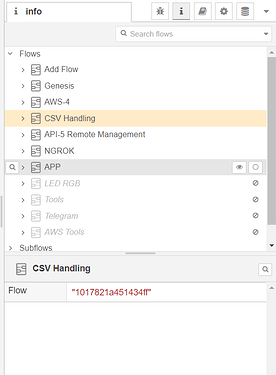Im sending below a sample of the override method for the Id function.
We apply it on settings.js using:
editorTheme: {
page: {
scripts: [path.join(__dirname, "path/to/the/script/below.js")]
},
After you apply this, all new nodes will use the ULID id generation, but Pasted nodes or Import flow will keep using the old id method (they will work fine), because inside the editor-client code, instead of using the "RED.nodes.id" into "importFlows" like all other functions, they used the "getID" directly and we cannot override that from page scripts.
To fix that, we currently monkey patched the editor-client code (When our node-red instance starts, it loads the red.js from the node_modules editor-client package, replace the getID usage and minify it again.
Also to save it ordered, we changed the Flow Manager lib (node-red-contrib-flow-manager (node) - Node-RED) to just order by the element "id" before saving.
console.log("Initializing id-override");
function createError(message) {
var err = new Error(message);
err.source = "ulid";
return err;
}
// These values should NEVER change. If
// they do, we're no longer making ulids!
var ENCODING = "0123456789ABCDEFGHJKMNPQRSTVWXYZ"; // Crockford's Base32
var ENCODING_LEN = ENCODING.length;
var TIME_MAX = Math.pow(2, 48) - 1;
var TIME_LEN = 10;
var RANDOM_LEN = 16;
function replaceCharAt(str, index, char) {
if (index > str.length - 1) {
return str;
}
return str.substr(0, index) + char + str.substr(index + 1);
}
function incrementBase32(str) {
var done = undefined;
var index = str.length;
var char = void 0;
var charIndex = void 0;
var maxCharIndex = ENCODING_LEN - 1;
while (!done && index-- >= 0) {
char = str[index];
charIndex = ENCODING.indexOf(char);
if (charIndex === -1) {
throw createError("incorrectly encoded string");
}
if (charIndex === maxCharIndex) {
str = replaceCharAt(str, index, ENCODING[0]);
continue;
}
done = replaceCharAt(str, index, ENCODING[charIndex + 1]);
}
if (typeof done === "string") {
return done;
}
throw createError("cannot increment this string");
}
function randomChar(prng) {
var rand = Math.floor(prng() * ENCODING_LEN);
if (rand === ENCODING_LEN) {
rand = ENCODING_LEN - 1;
}
return ENCODING.charAt(rand);
}
function encodeTime(now, len) {
if (isNaN(now)) {
throw new Error(now + " must be a number");
}
if (now > TIME_MAX) {
throw createError("cannot encode time greater than " + TIME_MAX);
}
if (now < 0) {
throw createError("time must be positive");
}
if (Number.isInteger(now) === false) {
throw createError("time must be an integer");
}
var mod = void 0;
var str = "";
for (; len > 0; len--) {
mod = now % ENCODING_LEN;
str = ENCODING.charAt(mod) + str;
now = (now - mod) / ENCODING_LEN;
}
return str;
}
function encodeRandom(len, prng) {
var str = "";
for (; len > 0; len--) {
str = randomChar(prng) + str;
}
return str;
}
function decodeTime(id) {
if (id.length !== TIME_LEN + RANDOM_LEN) {
throw createError("malformed ulid");
}
var time = id.substr(0, TIME_LEN).split("").reverse().reduce(function (carry, char, index) {
var encodingIndex = ENCODING.indexOf(char);
if (encodingIndex === -1) {
throw createError("invalid character found: " + char);
}
return carry += encodingIndex * Math.pow(ENCODING_LEN, index);
}, 0);
if (time > TIME_MAX) {
throw createError("malformed ulid, timestamp too large");
}
return time;
}
function detectPrng() {
var allowInsecure = arguments.length > 0 && arguments[0] !== undefined ? arguments[0] : false;
var root = arguments[1];
if (!root) {
root = typeof window !== "undefined" ? window : null;
}
var browserCrypto = root && (root.crypto || root.msCrypto);
if (browserCrypto) {
return function () {
var buffer = new Uint8Array(1);
browserCrypto.getRandomValues(buffer);
return buffer[0] / 0xff;
};
} else {
try {
var nodeCrypto = require("crypto");
return function () {
return nodeCrypto.randomBytes(1).readUInt8() / 0xff;
};
} catch (e) {}
}
if (allowInsecure) {
try {
console.error("secure crypto unusable, falling back to insecure Math.random()!");
} catch (e) {}
return function () {
return Math.random();
};
}
throw createError("secure crypto unusable, insecure Math.random not allowed");
}
function factory(currPrng) {
if (!currPrng) {
currPrng = detectPrng();
}
return function ulid(seedTime) {
if (isNaN(seedTime)) {
seedTime = Date.now();
}
return encodeTime(seedTime, TIME_LEN) + encodeRandom(RANDOM_LEN, currPrng);
};
}
function monotonicFactory(currPrng) {
if (!currPrng) {
currPrng = detectPrng();
}
var lastTime = 0;
var lastRandom = void 0;
return function ulid(seedTime) {
if (isNaN(seedTime)) {
seedTime = Date.now();
}
if (seedTime <= lastTime) {
var incrementedRandom = lastRandom = incrementBase32(lastRandom);
return encodeTime(lastTime, TIME_LEN) + incrementedRandom;
}
lastTime = seedTime;
var newRandom = lastRandom = encodeRandom(RANDOM_LEN, currPrng);
return encodeTime(seedTime, TIME_LEN) + newRandom;
};
}
var ulid = factory()
if (RED?.nodes) {
RED.nodes.id = function() {
return ulid();
}
console.log("Id function overrided!");
}
else {
console.log("RED.nodes not found.");
}


